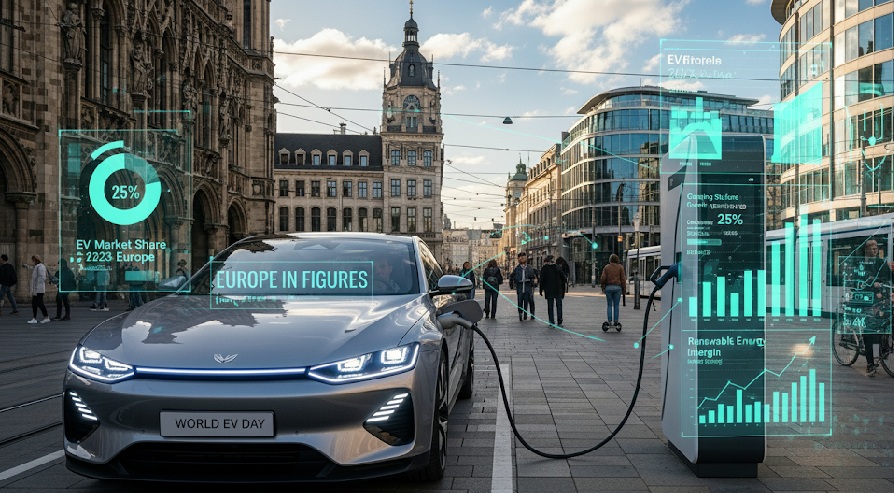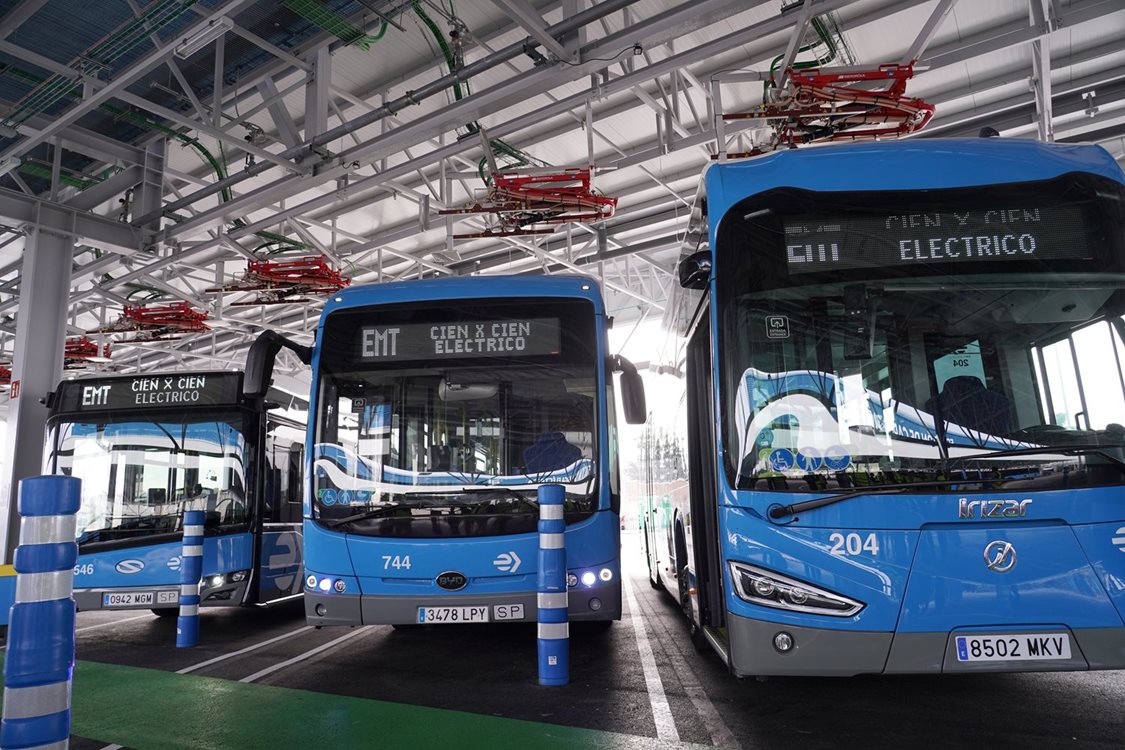This year, 2025, marks the sixth edition of World EV Day—a date established to raise awareness and promote the transition towards zero- and low-emission mobility.
Why is driving EV adoption crucial?
Because regions such as the European Union (EU), Norway, and the United Kingdom have already set concrete short-, medium-, and long-term targets to accelerate the phase-out of internal combustion engines and, consequently, reduce emissions from the transport sector.
In the EU’s case, a 55% reduction in CO₂ emissions from new cars and a 50% reduction from vans has been set for 2030, based on 2021 levels.
By 2035, the target is a 100% reduction, effectively marking the end of sales of vehicles with internal combustion engines.
The United Kingdom (UK), meanwhile, announced in April 2025 that it will ban the sale of new petrol and diesel vehicles from 2030.
Furthermore, from 2035 onwards, vans with such engines will also be phased out. In the interim period (2030–2035), only hybrid models will be permitted for sale.
As for Norway, the country aims for all new vehicles sold by 2025—including cars, vans, and urban buses—to be zero-emission, whether electric or hydrogen-powered.
To mark the occasion, Mobility Portal has produced a data-driven overview, based on EAFO (European Alternative Fuels Observatory) statistics, to compare the progress in electrified vehicle registrations (including battery electric and plug-in hybrid models) across different countries on the continent.

Germany, the UK and France: Leading the volume rankings
Germany leads by a wide margin in total registrations of electrified cars and vans, with 1,988,934 battery electric vehicles (BEVs) and 1,004,263 plug-in hybrid (PHEVs)—amounting to a combined total of 2,993,197 units.
The UK follows in second place, with 1,607,536 BEVs and 801,016 PHEVs, reaching a total volume of 2,408,552.
In third place is France, with 2,248,508 electrified vehicles, comprising 1,458,691 BEVs and 789,817 PHEVs.
Notably, all three countries have more fully electric vehicles than plug-in hybrids.
It’s also worth highlighting that there is a gap of over one million units between the third and fourth positions—marking a significant jump in the rankings.
Norway, despite being a leader in market penetration, ranks fourth in total volume. It has registered 1,101,624 electrified vehicles, including 892,756 BEVs and 208,868 PHEVs, reflecting a clear preference for fully electric units.
Next comes the Netherlands, with 1,097,630 electrified vehicles, divided between 652,212 BEVs and 445,418 PHEVs, showing a more balanced distribution between the two technologies.
Countries with the lowest volume of EVs
Among the countries with the lowest number of electrified vehicles is Latvia, with just 12,023 cars and vans registered—9,416 BEVs and 2,607 PHEVs.
Estonia follows with 16,114, of which 9,457 are electric and 6,657 are hybrids.
In the case of Croatia, the total stands at 20,307 electrified units, with a relatively even split: 11,002 BEVs and 9,305 PHEVs.
Slightly higher up is Slovakia, which has reached 30,643 units, made up of 17,705 BEVs and 12,938 PHEVs.
Lithuania reports 35,537 electrified vehicles, including 19,529 electric and 16,008 hybrids. While these figures are somewhat higher, the country still remains among the region’s laggards.
Tight race: Finland, Austria, Switzerland and Portugal
In the mid-range of the ranking, there’s only a small difference in the number of registered units, particularly between Finland, Austria, Switzerland, and Portugal, which occupy positions 10 to 13 respectively.
Finland has 326,287 electrified vehicles, with a preference for plug-in hybrids: 146,247 BEVs and 180,040 PHEVs.
Austria follows with 334,410 units, comprising 246,459 BEVs and 87,951 PHEVs—showing a stronger commitment to full electrification.
Switzerland reports 353,002 units, including 240,539 electric and 112,463 hybrids.
Portugal comes next with 357,259, divided between 206,987 BEVs and 150,272 PHEVs.
Close volumes in the next tier
Countries in the next tier of the ranking have similar volumes of electrified vehicles, with only tens of thousands of units separating them—though all have surpassed the half-million mark.
Spain, in 14th position, has registered 555,532 units, with a fairly balanced split: 263,445 BEVs and 292,087 PHEVs.
Just ahead is Denmark, with 584,379 electrified vehicles—a significant majority of which are BEVs (452,876) compared to 131,503 PHEVs, signalling a clear preference for fully electric mobility.
Italy comes in at 16th, with 683,152 units, also showing a nearly even distribution: 350,376 BEVs and 332,776 PHEVs.
Belgium follows closely with 706,267, comprising 359,983 electric and 346,284 hybrids, maintaining a very balanced mix.
Sweden rounds out this group in 18th place, with 757,992 vehicles, of which 435,968 are BEVs and 322,024 are PHEVs, solidifying its position among the countries with the highest absolute volumes in Europe.
DISCOVER MOBILITY PORTAL DATA
Explore Mobility Portal Data—a new, exclusive market intelligence platform that provides reliable data and key reports to support informed decision-making across the automotive sector.
It covers everything from combustion and electric vehicles to charging infrastructure.
With clear research, trend analysis, and up-to-date statistics, all in one place, Mobility Portal Data brings everything you need to one screen.
With Mobility Portal Data, smarter decisions are just a click away.
READ MORE
-
Atlante y su “modelo híbrido”: generación, almacenamiento y recarga ultrarrápida para un sistema más resiliente
Atlante acelera su despliegue en España y en diálogo con Mobility portal, Inés Mackey, Chief of Staff de Atlante Iberia define las prioridades de la empresa y su apuesta por la interoperabilidad de la mano de Charge League.
-
Spain Auto 2030: a point-by-point look at the plan set to redefine the eMobility landscape
Spain has entered a new phase in its industrial strategy for electric mobility. The Government has unveiled Spain Auto 2030, a roadmap designed to mobilise €30 billion over the next five years, reshaping the centre of gravity of the electric vehicle market through fresh incentives, a centralised management model, targeted investment in charging infrastructure and…
-
EMT Madrid licita 120 nuevos buses eléctricos: inversión de 79,35 millones y entregas entre 2026-2027
Con esta incorporación, Madrid refuerza su estrategia de descarbonización y consolida una de las flotas eléctricas urbanas más grandes de Europa.











